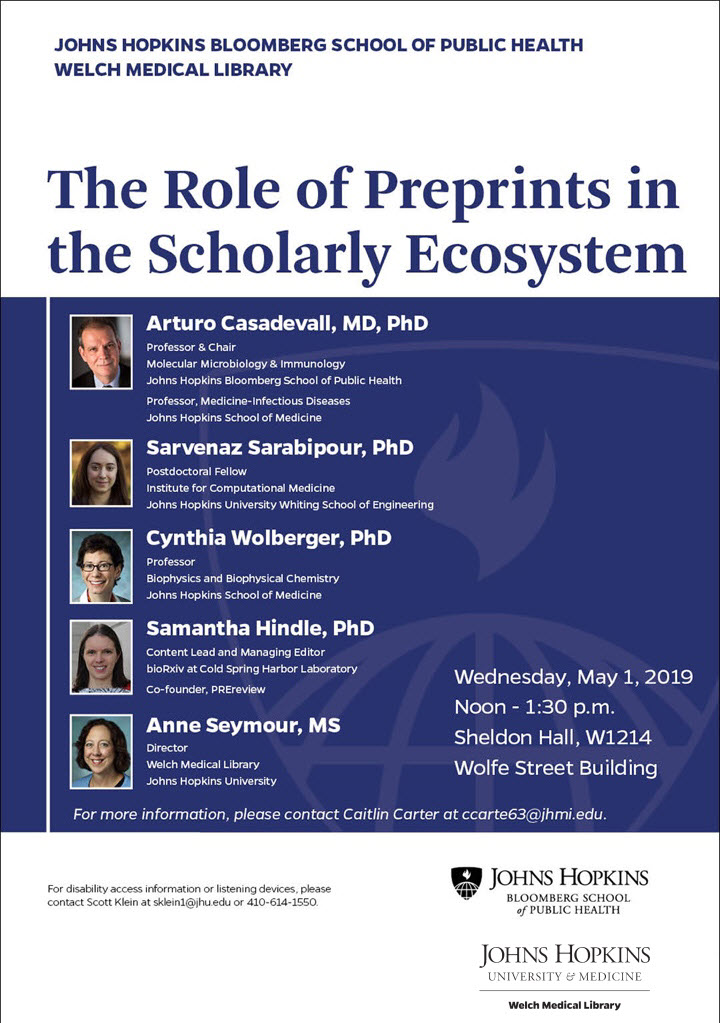“Your colleagues here are posting preprints.” - Dr. Cynthia Wolberger, JHUSOM

The scholarly publishing landscape is rapidly changing, and with change comes many benefits for scientists like faster dissemination of, control over, and access to research. Changes also cause confusion, especially when navigating what rights authors have to share versions of research like preprints.
Since 1991, preprint posting has grown quickly.
Hopkins alone has 1,584 preprints in bioRxiv, but many researchers still wonder: will I get scooped, what if non peer-reviewed research contributes to misinformation, and can I still publish my research in a journal if I share a preprint?
Recognizing a need to address the nuances of preprint culture, Welch Library and the Johns Hopkins Bloomberg School of Public Health co-sponsored a panel event on May 1, 2019, inviting faculty, staff, and students to attend, watch live, and contribute to a lively discussion about the role of preprints in academic publishing.
Anne Seymour, Director of Welch Medical Library, moderated our panel, which included two Johns Hopkins faculty members, Arturo Casadevall and Cynthia Wolberger; a Johns Hopkins postdoctoral fellow, Sarvenaz Sarabipour; and the content lead and managing editor for bioRxiv, Samantha Hindle, visiting from Cold Spring Harbor Laboratory.
What follows is a brief description and list of major highlights from the presentations.
A link to a recording of the event can be found here.
Definition:
“A preprint is a complete Scientific manuscript that is uploaded by the authors to a public server. The preprint contains complete data and methodologies; it is often the same manuscript being submitted to a journal.”

Event Highlights:
Dr. Casadevall led by describing how preprints are disrupting the sciences just as Uber disrupted the taxi industry:
-
In his recent study, he and his co-authors examined gender disparities in the first authorship role. First published as a preprint, the preprint was shared on social media right away, and Science featured it two weeks later. A year and a half later, after three rounds of reviews, the paper was published in a peer-reviewed journal. Preprints are an enormous accelerator.
-
Preprint journal clubs have the potential to improve science. Dr. Casadevall described a journal club review that provided far better feedback on a paper than the peer review process normally produces.
Dr. Sarabipour discussed the importance of a positive, open publishing system that promotes a culture where trainees and early career researchers are stimulated to publish work and take ownership when they want, not when journals decide:
-
Preprints may be able to liberate the peer review process. Based on results reported in Nature, only 20% of scientists review 80-90% of journal papers, and of that 20%, only 20% are women. Both men and women invite fewer women to review papers. More female trainees can review preprints and become confident in the ability to review papers.
-
A system where overlay journals constantly review papers will help us move away from a paternalistic system of doing science and toward a positive and egalitarian system.
Dr. Wolberger described the importance of posting preprints for grant reviewers:
-
Science, Nature, Cell, PNAS PLOS, and more are preprint friendly. Some journals even solicit publications from bioRxiv.
-
Two years ago, the NIH announced support for interim research products like preprints to speed dissemination and enhance rigor of work.
-
You can cite preprints in your bibliography, NIH Biosketch, and grant proposals and reports. Endnote is set up to cite preprints, and you can list preprints in your annual progress report as evidence of productivity.
-
For many grant reviewers, “manuscript submitted” is no longer a satisfactory phrase. In Dr. Wolberger’s study section experience, she has seen reviewer comments asking for a preprint instead.
Dr. Hindle presented statistics from biorXiv. She also discussed PREreview, a platform she co-founded two years ago for journal clubs collaboratively reviewing preprints. The purpose is to change the “HOW, WHEN and WHO of peer review” to increase the diversity and inclusiveness of the process:
-
2,000 manuscripts are posted in bioRxiv every month from 110 countries in the world.
-
Around 65% of the manuscripts on biorXiv are published in journals, and 1,600 journals have published biorXiv preprints.
-
BiorXiv receives 2.5 million readers per month.
-
80% of bioRxiv authors are submitting papers before or at the same time they submit their manuscripts to their top choice journals.
-
44% of authors receive comments via Twitter.
For more information about preprints and other scholarly communication topics, please contact Barbara Pralle ([email protected]).